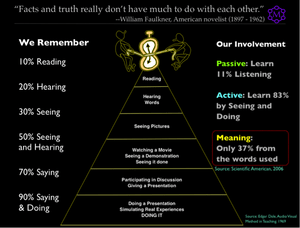Differences — People think differently.
As session leader, you empower participants and their ability to understand and communicate with each other. Additionally, you enable them to think creatively about their business. Hence, the following two subjects deal with the way people think—horizontal/ vertical thinking and paradigms.
Horizontal/ Vertical
Participants in a workshop argue over a seemingly simple issue. Consequently, two people hear the same thing and react as if they were in different meetings. Why? Because people interpret information differently. Meanwhile, there are many theories about how people process information.
One theory states that the two spheres of the brain, the right and the left, govern our thinking with right brain or left brain thinking.
However, another theory that explains the differences more clearly is Communicoding. This theory states that there are two modes of thinking for processing information, vertical and horizontal. These two modes of thinking may have a difficult time communicating with each other because the way that each perceives the world is different. What are they?
Vertical Thinker
A vertical thinker is often described as very logical, organized, and detail-oriented. Therefore, vertical thinkers:
- Easily discern the immediate dynamics of a problem.
- Identify specific details and relate issues to reality.
- Know what can be accomplished within a given time.
- See barriers and obstacles to be removed.
- Take the likely paths to reach results.
- Work well in structured environments.
The vertical thinker’s main characteristic is that they find differences. Vertical thinkers can decompose something and design something new from the pieces. They work from exclusion.
Horizontal Thinker
A horizontal thinker is often described as far-sighted, innovative, and conceptual. Therefore, horizontal thinkers:
- Easily discern the underlying dynamics of a problem.
- Identify contextual details—relating issues to a larger perspective.
- Know what impact can be achieved within a given context.
- See possibilities and benefits to strive for.
- Take the unlikely paths to reach results.
- Work well in unstructured environments.
Horizontal thinkers’ main characteristic is that they find similarities. They are able to find the common thread—to make new associations among unrelated items. They work from inclusion.
To Identify
As a facilitator, you cannot change the way people think—and never label participants. You do help the participants in a workshop learn to hear each other and to better understand their communication challenges. Clues that thinking differences are causing problems are:
- One person argues about the problems while another is focused on the benefits.
- One person trying to get to the details while the other is trying to focus on the ideas.
- People use the same words yet meaning something different or arguing as if they are saying something different.
- Using different words that seem to be saying the same thing.
To Fix
When you hear communication problems consider the following:
- Capture what each person is saying—write it on the flip charts without putting their names by the ideas.
- Draw pictures using visual aids, flip charts, and models. By using visual support or other exercises, participants learn about their business.
- Get the group to see both similarities and differences.
- Move the focus of the group away from people and onto the issue(s) at hand.
- Summarize both similarities and differences and get the group to decide what to do with them or move along to the next step.
Register for a class or forward this to someone who should. MGRUSH‘s professional facilitation curriculum focuses on practicing methodology. Each student thoroughly practices and rehearses tools before class concludes. While some call this immersion, we call it the road to building impactful facilitation skills.
______
Don’t ruin your career by hosting bad meetings. Sign up for a workshop or send this to someone who should. MGRUSH workshops focus on meeting design and practice. Each person practices tools, methods, and activities every day during the week. Therefore, while some call this immersion, we call it the road to building high-value facilitation skills.
Our workshops also provide a superb way to earn up to 40 SEUs from the Scrum Alliance, 40 CDUs from IIBA, 40 Continuous Learning Points (CLPs) based on Federal Acquisition Certification Continuous Professional Learning Requirements using Training and Education activities, 40 Professional Development Units (PDUs) from SAVE International, as well as 4.0 CEUs for other professions. (See workshop and Reference Manual descriptions for details.)
Want a free 10-minute break timer? Sign up for our once-monthly newsletter HERE and receive a timer along with four other of our favorite facilitation tools, free.

Terrence Metz, president of MG RUSH Facilitation Training, was just 22-years-old and working as a Sales Engineer at Honeywell when he recognized a widespread problem—most meetings were ineffective and poorly led, wasting both time and company resources. However, he also observed meetings that worked. What set them apart? A well-prepared leader who structured the session to ensure participants contributed meaningfully and achieved clear outcomes.
Throughout his career, Metz, who earned an MBA from Kellogg (Northwestern University) experienced and also trained in various facilitation techniques. In 2004, he purchased MG RUSH where he shifted his focus toward improving established meeting designs and building a curriculum that would teach others how to lead, facilitate, and structure meetings that drive results. His expertise in training world-class facilitators led to the 2020 publication of Meetings That Get Results: A Guide to Building Better Meetings, a comprehensive resource on effectively building consensus.
Grounded in the principle that “nobody is smarter than everybody,” the book details the why, what, and how of building consensus when making decisions, planning, and solving problems. Along with a Participant’s Guide and supplemental workshops, it supports learning from foundational awareness to professional certification.
Metz’s first book, Change or Die: A Business Process Improvement Manual, tackled the challenges of process optimization. His upcoming book, Catalyst: Facilitating Innovation, focuses on meetings and workshops that don’t simply end when time runs out but conclude with actionable next steps and clear assignments—ensuring progress beyond discussions and ideas.




